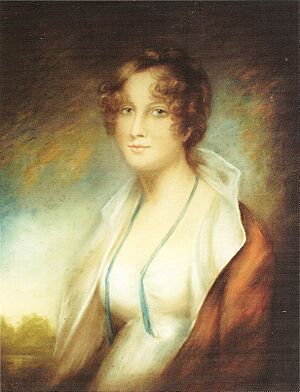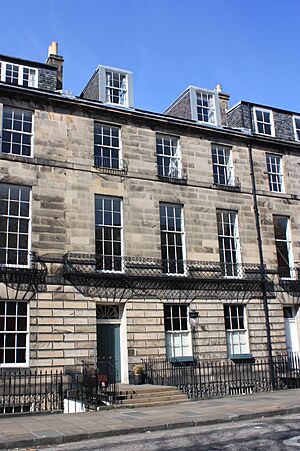Alexander Campbell of Possil facts for kids
Quick facts for kids
Colonel Alexander Campbell of Possil
|
|
|---|---|

The portrait of Colonel Alexander Campbell of Possil by Sir Henry Raeburn 1756–1823. Exhibited: Edinburgh Raeburn Exhibition of 1876 no. 205. Other portraits of the Campbells of Possil belonging to the family were also exhibited at the 1876 Raeburn exhibition.
|
|
| Allegiance | United Kingdom |
| Service/ |
British Army |
| Rank | Colonel |
| Relations | General George Carter-Campbell, Major General Sir Archibald Campbell K.B. of Inverneill, Colonel Duncan Carter-Campbell of Possil, General Sir James Campbell of Inverneill, Willoughby Harcourt Carter |
Colonel Alexander Campbell of Possil (1754–1849) was a Scottish soldier who served in the British Army for many years. He started his military journey as a young officer in 1769. He was part of important events in history, like the American War of Independence. He later became a high-ranking officer.
Contents
A Life in the Army
Alexander Campbell began his army career in April 1769. He joined the 42nd Regiment as an ensign. The next year, he became a lieutenant in the 2nd Battalion Royals in Menorca.
Early Military Adventures
Later in 1770, he moved to the 62nd Regiment in Ireland. He then traveled with his regiment to Canada. As a captain, he fought in the American War of Independence. He was part of campaigns in 1776 and 1777 with General Burgoyne.
After the British forces surrendered at Saratoga, he went to New York. There, he was promoted to major. He joined the 1st Battalion of Light Infantry. In 1782, he became a lieutenant-colonel of the 62nd Regiment. Soon after, he returned to Scotland. He stayed with his regiment there until 1789.
Fighting in the West Indies
In the 1790s, Colonel Campbell served with the Duke of York. He was promoted to colonel on October 1, 1793. In 1794, he formed a new regiment, the 116th Regiment. He became their first brigadier-general. He was sent to the West Indies under Sir Ralph Abercromby. On November 10, 1796, he was made colonel of the 7th West India Regiment.
Later Career and Important Battles
Colonel Campbell returned to Scotland in the late 1790s. He worked on the Staff in Ireland and Scotland for five years. On July 11, 1804, he became colonel of the 19th Foot. He fought in battles in South Africa. He was present when the Cape of Good Hope was captured in 1806.
He also fought in the battle of Corunna in Spain. There, he led the 20th Regiment. He was promoted to general on January 1, 1812. In February 1813, he became colonel of the 32nd Foot.
Wealth and Land
Colonel Campbell was a wealthy man. He owned large areas of land in Scotland. His family also had business connections in the West Indies.
How He Gained Wealth
After the Slavery Abolition Act 1833 ended slavery in British territories, the government paid money to former slave owners. This was done through the Slave Compensation Act 1837. Records show that Alexander Campbell received a payment of £6,113. This money was connected to land he owned in Grenada. At the time, this was a very large sum of money.
His Homes and Estates
In 1808, Colonel Campbell took over the Possil estates in Lanarkshire. He got these from his father, John Campbell. His father had a trading business in Glasgow that dealt with the West Indies. Alexander also acquired the estates of Torosay and Achnacroish on the Isle of Mull. These were in Argyllshire, Scotland.
In the 1830s, Alexander Campbell lived at 12 Abercromby Place in Edinburgh. This was a grand townhouse overlooking Queen Street Gardens.
See also

- Torosay Castle
- Possil Estate (Possil Park today)
- Duart Castle
- Clan Campbell
- Clan Maclachlan
- Clan Lamont
- Henry Raeburn


